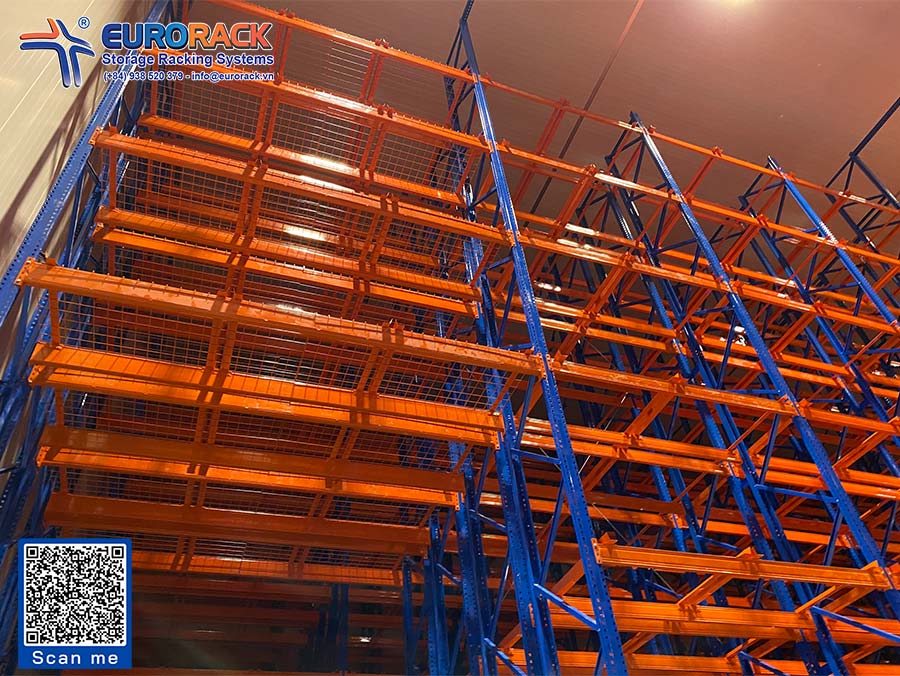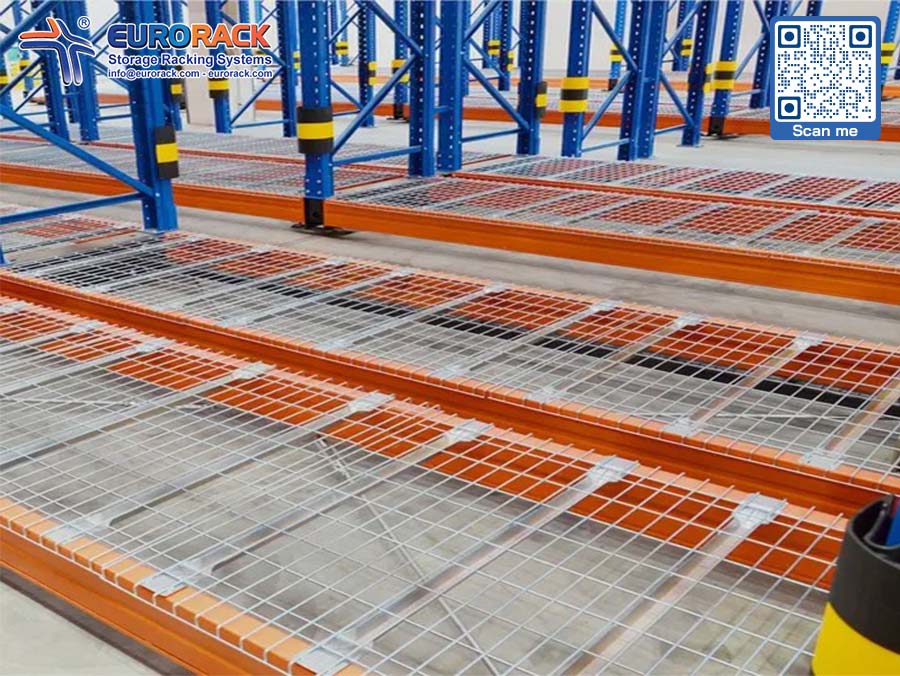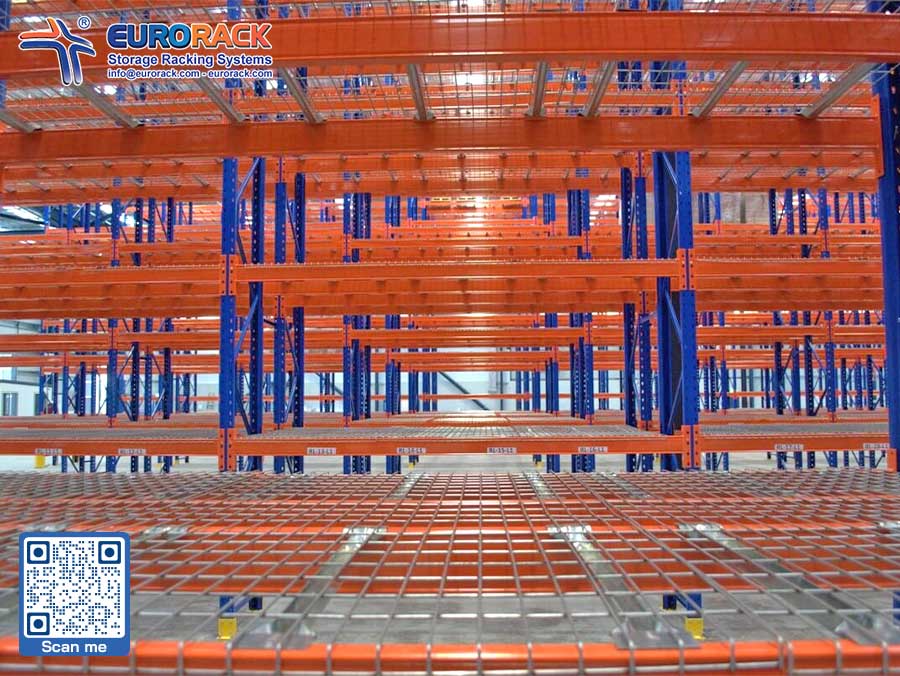- Hotline: (+84) 938 520 379
- Email: info@eurorack.com
EURORACK MECHANICAL JSC
| Table Of Contents |

Introduction to Genuine Eurorack Mesh Decking
Mesh decking, commonly referred to as wire decking, is a heavy-duty steel platform used within pallet racking systems to provide secure and stable support for stored goods. Its open-grid structure minimizes the risk of items slipping or falling—particularly when storing smaller or unevenly shaped products.
Beyond improving safety, these mesh panels optimize warehouse operations by enhancing visibility, airflow, and fire suppression compatibility. This smart addition contributes to a more efficient storage flow while reducing potential losses and maintenance costs for businesses.
When it comes to mesh decking used in pallet racking systems, certain specifications are standardized, while others are customized based on individual operational requirements. Below is an overview of its key technical attributes:
| Quality Certifications: Mesh decking products are evaluated based on various quality benchmarks. Among the most recognized and widely adopted are EN 1090—used across Europe, and ISO 9001, which is the global standard for quality management and production processes. |
| Typical Mesh Dimensions: Standard grid sizes commonly used include 50×50, 50×100, 100×100, 120×120, 120×150, and 150×150 cm. |
| Wire Thickness: Each wire used in the mesh panel typically ranges between 5 mm and 6 mm, ensuring a flat and stable surface capable of handling different weight categories. |
| Support Bars (Reinforcement Structure): Underneath each mesh panel, you’ll find structural reinforcement in the form of omega-shaped support bars, usually 2 mm thick. A minimum of two bars are used per panel, with more added depending on panel dimensions and required load capacity. |
| Load Capacity: Built entirely from high-strength steel and supported by a robust reinforcement system, mesh decking panels are capable of supporting loads from 100 kg up to 700 kg per unit. |
| Surface Finishes: To enhance corrosion resistance and visual appeal, mesh decking is treated with surface coatings. Common finishing methods include electrostatic powder coating, as well as zinc galvanization—either via electroplating or hot-dip galvanizing, depending on usage environments. |

Storage racking use mesh floors with support bars to withstand heavy loads
When a product is thoughtfully developed and applied in real-world operations, its true value emerges in both performance and practical benefits. Wire mesh decking is no exception—it plays an essential role in optimizing warehouse racking systems. Here’s how:
In fast-paced warehouse environments, forklift operators may struggle to accurately position pallets onto racks. Minor misjudgments can lead to dangerous misplacements or even accidents. Installing mesh decking provides a flat, secure surface that minimizes the risk of goods slipping through or tipping over, thereby improving overall warehouse safety.
Traditionally, placing pallets directly on steel beams caused friction that gradually wore away protective paint, exposing the surface to rust and reducing lifespan. Mesh decking acts as a buffer layer between the goods and rack structure, reducing direct contact and preserving the integrity of the beam’s finish.
Designed with ease of use in mind, mesh decking panels require no bolts or screws to install. Their design ensures a snug fit that stays securely in place simply by resting on the rack beams—allowing for fast deployment or repositioning when needed.
Constructed from corrosion-resistant steel and treated with electrostatic powder coating or galvanized finishes, mesh decking performs reliably even in challenging environments such as cold storage facilities. Whether your warehouse operates at room temperature or below freezing, mesh decking maintains its strength and stability.
Thanks to its open-grid design and reflective surface, wire mesh decking helps enhance overall brightness in your storage area. Better light dispersion means product labels are more visible, picking accuracy is improved, and the workspace feels more organized and efficient.
If your business is planning to incorporate wire mesh decking into its storage system, it's essential to evaluate several factors to ensure safety, compatibility, and cost-effectiveness. Below are important points to keep in mind before moving forward with implementation.
Mesh decking is not a one-size-fits-all solution—its structure and load capacity must align with the nature of the items stored. Products with varying dimensions and weights require different mesh specifications. Therefore, it’s crucial to work closely with the manufacturer to determine essential parameters, such as:
Average and maximum load per level
Warehouse layout and racking structure
Providing accurate operational data will help prevent design mismatches, avoid unnecessary costs from incorrect sizing, and—most importantly—ensure the safety of your warehouse team while maintaining product integrity.
Mesh decking isn’t compatible with every racking type. Systems such as drive-in racks, shuttle racks, push-back racks, flow racks, cantilever systems, or mold racks are generally unsuitable for mesh panel installation due to the lack of designated support surfaces.
However, many commonly used storage systems are mesh-friendly, including:
Very Narrow Aisle (VNA) racks
Double Deep racks
Mobile racking systems
Medium-duty (mid-load) racks
If you're planning a new installation or upgrading an existing setup, be sure to choose a rack design that aligns with mesh decking integration. At Eurorack, we specialize in fabricating mesh decking tailored specifically for VNA rack systems, where precision and space efficiency are critical.

Eurorack specializes in constructing high-quality, reliable steel mesh decking for Pallet Selective Racking
Accurate measurement of the rack's beam width and depth is essential when designing mesh decking. These dimensions directly determine whether the mesh panel will fit securely onto the beam structure.
If the panel is too small, it may shift or create dangerous gaps—posing a hazard for falling goods.
If the panel is too large, it may obstruct forklift access and increase unnecessary material costs.
In both cases, poor sizing can lead to operational inefficiencies, higher expenses, and potential safety concerns. Always ensure these measurements are verified before placing an order.
In modern warehouse operations, mesh decking has become a widely adopted component for enhancing both safety and functionality. While not every racking system is suitable for mesh integration, three types stand out as ideal for this application. Let’s explore them along with their distinctive benefits:
Selective racking is one of the most common storage solutions in warehouses. When combined with wire mesh decking, the system is upgraded with a steel-mesh platform that spans across the two horizontal beams of each level, providing added support and load stability.
The open-grid design enhances visibility and allows light to penetrate, making inventory identification and forklift access much more efficient. Support bars beneath each mesh panel reinforce structural integrity for stored pallets.
Key Advantages:
Compatible with cold storage environments
Cost-effective and easy to install
Flexible layout and convenient access to individual SKUs
Simple to clean, remove, or reposition as needed
Double Deep Racking is essentially two selective racks placed back-to-back, allowing deeper storage and increased density. When mesh decking is installed on each level, it divides the rack into reinforced sections that provide better support for heavy or bulk goods.
Prior to the use of mesh panels, goods stored deep inside the rack posed a risk of falling or instability. With mesh decking in place, both safety and operational flow are significantly improved.
Key Advantages:
Ideal for high-volume storage
Supports quick pallet retrieval with reach trucks
Boosts safety during loading/unloading operations
Suitable for warehouses with diverse product categories like FMCG, components, or raw materials
VNA racking systems are designed for maximum vertical storage within minimal floor space, commonly reaching heights of 15–18 meters or more. These systems are best suited for high-density storage environments where floor area is limited.
While VNA configurations optimize space, they also limit visibility—especially at upper levels. Integrating mesh decking into VNA racks provides a flat, secure surface that supports pallets while also allowing light through, helping improve operator visibility and safety.
Key Advantages:
Customizable to specific warehouse floor plans
Maximizes vertical space usage
Reduces handling time per pallet
Enhanced stability and surface contact via reinforced footplates
When it comes to wire mesh decking, choosing a trusted manufacturer is crucial to ensuring long-term performance, safety, and operational efficiency. Eurorack has established itself as a leading name in the production of steel mesh decking, offering tailored solutions that meet both international standards and unique warehouse demands. Here’s why Eurorack remains the preferred partner of many businesses:
At Eurorack, every customer receives attentive consultation from experienced support staff. Our team works closely with you to:
Identify the ideal quantity and size of mesh panels
Recommend the best-fit surface treatments for your specific storage environment
Provide optimized layout solutions based on your rack type and warehouse conditions
This level of attention ensures that each solution is both technically accurate and operationally practical.

Eurorack is a trusted manufacturer of premium Mesh Decking solutions for industrial racking systems
Eurorack leverages advanced automation technology throughout the manufacturing process. From precise steel cutting and edge bending to heat welding and assembly, every stage is controlled via a centralized system that activates production only upon receiving a task order.
This streamlined workflow delivers:
Precise alignment and seamless joints
Uniform product quality across every batch
Enhanced surface finish due to reduced manual welding heat exposure
By embracing automation, Eurorack guarantees accuracy, consistency, and minimal defects in every piece of mesh decking produced.
To ensure long-term durability, Eurorack sources its steel from Vietnam’s top-tier suppliers including Hoa Phat, Pomina, and Van Loi. These raw materials form the foundation for mesh decking that stands up to high loads and challenging environments.
The surface of each panel is treated using:
Electrostatic powder coating – for visual appeal and corrosion resistance
Zinc galvanization (electroplated or hot-dip) – for environments with high humidity or temperature variation
These treatments help extend product lifespan up to 10 years or more, providing excellent return on investment.
All Eurorack products undergo strict inspection procedures, including weight load testing and dimensional checks. Customers also receive printed usage guidelines to promote safety and compliance on-site.
Eurorack is committed to helping you make the most of your storage system. To get started, simply prepare the key specifications outlined in our “Considerations Before Installation” guide, then send them along with layout drawings to our team for tailored consultation.
Please contact Eurorack if you have any questions.